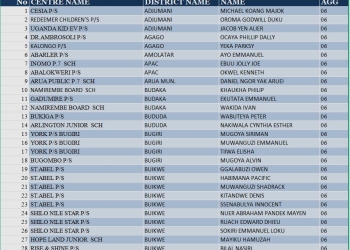
KAMPALA, Uganda — Experts under the Civil Society Coalition on Transport (CISCOT) are calling on the Ugandan government to accelerate the development of its railway infrastructure, asserting that a robust rail network could yield significant reductions in freight costs, ease the movement of bulk goods, lower greenhouse gas emissions, and improve urban public transportation, potentially saving the government billions of shillings annually.
According to a recent CISCOT report, titled “Implementation of NITMP 2021–2040: Project Prioritisation and Budget Allocation to the Road Sub-sector,” the National Integrated Transport Master Plan (NITMP) aims to expand and modernize both regional and Greater Kampala Metropolitan Railway Passenger Services, which experts believe holds substantial cost-saving potential for the government.
The report emphasizes the critical need to rehabilitate the existing meter gauge railway, protect vital transport corridors, construct the Gulu Logistics Hub, and further expand rail tracks through the Standard Gauge Railway (SGR) project.
CISCOT acknowledges progress made by the Uganda Railways Corporation (URC), including the completion of the Tororo–Namanve (222km) railway line and the construction of the Gulu Logistics Hub. However, the experts point out ongoing delays in key areas.
“Delays in railway station rehabilitation and locomotive procurement hinder the full operationalisation of passenger and cargo services,” the report states.
While the NITMP sets targets of a 3% annual shift from cars to public transport and a 10% shift from road to rail by 2040, the report indicates that significant work remains to achieve these goals. The URC has taken steps by reviving some passenger train services, primarily on the Kampala–Mukono route, serving commuters in the capital. However, the implementation of detailed designs for the Kampala multi-modal hub is still pending. Experts also urge the extension of passenger rail services to the Kampala–Nalukolongo and Kampala–Port Bell sections.
Regarding the SGR, while a 2.7 billion euro contract has been signed with Turkish firm Yapi Merkezi for the eastern route (Tororo to Kampala), CISCOT calls for expedited action. The government released 479 billion shillings in the third quarter of the current financial year to facilitate the project’s commencement. According to SGR Uganda Project co-ordinator Can. Eng. Perez Wamburu, construction of the 272km line is expected to take 48 months, with approximately 54% of the required Right of Way acquired between Malaba and Mayuge.
Uganda’s long-term vision includes developing 1,700km of SGR in phases, encompassing the Northern, Western, and Southern lines.
Despite these efforts, CISCOT experts continue to criticize chronic underfunding of the transport sector, attributing it to insufficient national budget allocations.
“The budget for asset management has constantly declined, falling far short of the recommended sh1.25 trillion per year. This undermines the long-term viability and benefits gained from transport investment,” the report notes.
The experts also observed a general decline in investment across all transport modes over the past four years, warning of detrimental effects on the NITMP’s objectives. Poor coordination among key government agencies and utility companies was also cited as a cause of project delays. CISCOT recommends establishing a central coordination unit to enhance institutional collaboration and emphasizes the importance of early land acquisition to avoid project delays and rising costs. They advocate for equitable land reforms to facilitate compulsory land acquisition by the state.
While the NITMP has seen some progress, with 68 out of 81 key actions or projects showing advancement in its first five years (2021–2025), slow progress due to inadequate financing has led to delays and increased costs.
Lawrence Ssengendo, the CISCOT chairperson, highlighted the disproportionate allocation of the Integrated Transport Infrastructure and Services programme budget, with the roads sub-sector receiving 81% between FY2020/21 and FY2023/24, while railways received only 6% and inland waterways a mere 3%. He argued that this underfunding of rail and water transport represents a missed opportunity for economic development and achieving the NITMP’s goal of reducing trade costs.

















